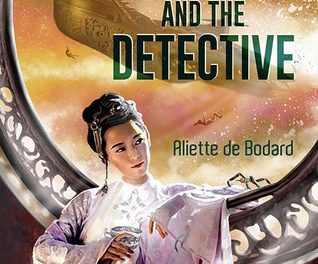 What’s It About
What’s It About
It’s 1920s England (Ellchester to be exact) and Triss has woken up after an accident to discover that (a) she has significant holes in her memory (b) her parents are acting strangely around her and (c) her little sister Pen utterly hates her. But that’s just the beginning. When dolls start coming alive in her hands, and birds start speaking to her, Triss realises that she’s either going mad or something other-worldly is simmering under the surface. Something connected to a mysterious figure known only as The Architect.
Should I Read It?
YES! I’m reluctant to say much more about the novel as it’s one of those books where part of the pleasure comes from uncovering the truth along with the main character. What I can say is that Hardinge’s handling of narrative, of style, of plot beats, of characters, of atmosphere and of theme is first rate. For those who have read Hardinge’s previous novels, this will come as no surprise.
Representative Paragraph
You want a brilliant turn of phrase?! Well I’ll give you two – Hardinge’s pitch perfect descriptions of jazz
This was a record that had been places and come back scratched, and somehow the roughness made it seem all the more itself. This jazz had not wiped its feet; it crunched right into the room with gravel on its shoes.
and
Triss had heard jazz with neatly wiped shoes and jazz with gritty soles and a grin. And this too was jazz, but barefoot on the grass and blank-eyed with bliss, its musical strands irregular as wind gusts and unending as ivy vines. It was not human music; she could tell that in an instant. This was truer, purer and more chaotic, but also . . . colder. Human jazz was a clumsy imitation of this music, but it had blood, breath and warmth to it.
Commentary
One of the disadvantages of setting myself the goal of reading between 15 and 20 genre and literary award shortlists is that when I come across a novel I adore I don’t have the time or luxury to explore the author’s backlist. Because that’s what I’d be doing now, gobbling up Hardinge’s five other books rather than exposing myself to a bunch of mediocre horror novels. It’s entirely my fault. I’ve been aware of Hardinge’s work for years, regularly coming across reviews from people whose tastes I respect, gushing and squeeing at her work. I’ve had ample time to read one of the novels. But it’s taken this silly project of mine for me to realise what I’ve been missing out on.
What immediately struck me about Cuckoo Song was the quality of the writing. Nearly every page features a considered metaphor or simile that perfectly renders and crystallizes the moment Hardinge is describing. You only have to read the above descriptions of jazz to see what I mean. But even in moments of action and horror, Hardinge settles on exactly the right word or phrase creating an effect that’s both chilling and cinematic:
The Besider man split like a cloud before the moon, and light spilled out, wet light that screamed as it came. His mouth opened wide and ghostly ribbons spiralled out into the air, chittering forgotten tales. As they pulled away from him and vanished, he seemed to unravel, twitching. Soon there was nothing left but a grey-brown coat slumping to the cobbles.
What’s astounding is that the novelty never wears off, your constantly surprised and delighted by the way Hardinge describes her characters and her world.
I also appreciated how Hardinge did something innovative with familiar ideas. Whether that be taking inspiration from the Golem or Faust or drawing on the battle between chaos and order, in her hands these concepts and tropes feel new and exciting. It all culminates in the introduction of the Besiders, a beautifully imaginative community of amoral beings that thrive on uncertainty. Straight lines and order and cartography are an anathema to them. So are scissors – they snip things in two… they divide by force – and church bells – the sharing of faith makes the Besiders sick.
This idea of uncertainty versus certainty informs the mental states and motivations of the main players in the novel. Triss faces constant uncertainty in relation to her identity, which only deepens once she realises what she is. Interestingly, this uncertainty fuels her need to act, to find answers, to save the day if she can, even if it means her destruction. Her parents face the uncertainty and confusion of a son that may or may not have died during the First World War. Their reaction is to place cotton-wool around their surviving children, providing a stultifying and unbearable environment. And the Besiders, ironically face an uncertain future as the world around them solidifies It’s this inevitability that motivates The Architect’s nefarious, evil plan which wonderfully has all the hallmarks of a traditional alien invasion.
I just loved this book. I loved the writing, the ideas, the complexity of the themes and – though I haven’t really discussed them in the review – the characters, specifically Triss and Pen. Their sisterly relationship is a highlight in novel that’s filled with highlights.


Trackbacks/Pingbacks